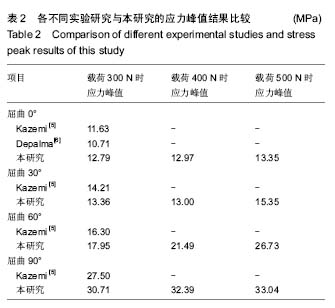| [1] Pujol N, Tardy N, Boisrenoult P, et al. Magnetic resonance imaging is not suitable for interpretation of meniscal status ten years after arthroscopic repair. Int Orthop. 2013; 37(12):2371- 2376.[2] 中国解剖学会体质调查委员会编.中国人解剖数值[M].北京:人民卫生出版社,2002:27.[3] McNulty AL, Guilak F. Mechanobiology of the meniscus. J Biomech. 2015; 48(8):1469-1478. [4] DeVries Watson NA, Duchman KR, Bollier MJ, et al. A Finite Element Analysis of Medial Patellofemoral Ligament Reconstruction. Iowa Orthop J. 2015; 35:13-19.[5] Kazemi M, Dabiri Y, Li LP. Recent advances in computational mechanics of the human knee joint.Comput Math Methods Med. 2013; 2013:718423. [6] Depalma AF. Diseases of the knee. J Bone joint surg Am. 1955;37:661-662.[7] Lee BI, Kim BM. Concomitant Osteochondral Autograft Transplantation and Fixation of Osteochondral Fragment for Treatment of a Massive Osteochondritis Dissecans: A Report of 8-Year Follow-up Results. Knee Surg Relat Res. 2015; 27(4):263-268.[8] Haase K, Rouhi G. A Discussion on Plating Factors that Affect Stress Shielding Using Finite Element Analysis. J Biomed Sci. 2010;5(2):129-141.[9] Geramy A, Shahroudi AS. Fixed versus Removable Appliance for Palatal Expansion; A 3D Analysis Using the Finite Element Method. J Dent (Tehran). 2014; 11(1):75-84.[10] Tan J, Mu M, Liao G,et al. Biomechanical analysis of the annular ligament in Monteggia fractures using finite element models. J Orthop Surg Res. 2015;10:30. [11] Li Q, Ren S, Ge C, et al. Effect of jaw opening on the stress pattern in a normal human articular disc: finite element analysis based on MRI images. Head Face Med. 2014; 10:24.[12] Hazrati Marangalou J, Ito K, van Rietbergen B.A new approach to determine the accuracy of morphology-elasticity relationships in continuum FE analyses of human proximal femur. J Biomech. 2012;45(16):2884-2892.[13] Liong K, Lee SJ, Lee HP. Preliminary Deformational Studies on a Finite Element Model of the Nasal Septum Reveals Key Areas for Septal Realignment and Reconstruction.J Med Eng. 2013; 2013:250274.[14] Argatov I, Mishuris G. Articular Contact Mechanics from an Asymptotic Modeling Perspective: A Review.Front Bioeng Biotechnol. 2016; 4:83. [15] Besier TF, Pal S, Draper CE, et al. The Role of Cartilage Stress in Patellofemoral Pain.Med Sci Sports Exerc. 2015; 47(11):2416-2422.[16] Chan DD, Cai L, Butz KD, et al. In vivo articular cartilage deformation: noninvasive quantification of intratissue strain during joint contact in the human knee.Sci Rep. 2016; 6: 19220.[17] Wheatley BB, Fischenich KM, Button KD,et al. An optimized transversely isotropic, hyper-poro-viscoelastic finite element model of the meniscus to evaluate mechanical degradation following traumatic loading. J Biomech. 2015; 48(8): 1454-1460.[18] Chen X, Zhou Y, Wang L, et al. Determining Tension- Compression Nonlinear Mechanical Properties of Articular Cartilage from Indentation Testing.Ann Biomed Eng. 2016; 44(4):1148-1158.[19] Peloquin JM, Santare MH, Elliott DM. Advances in Quantification of Meniscus Tensile Mechanics Including Nonlinearity, Yield, and Failure. J Biomech Eng. 2016; 138(2): 021002.[20] Homyk A, Orsi A, Wibby S, et al. Failure locus of the anterior cruciate ligament: 3D finite element analysis. Comput Methods Biomech Biomed Engin, 2012;15(8):865-874.[21] ABAQUS,Version 6.10 Documentation, ABAQUS Analysis Manual Simulia, Dassault Systèmes,33 RI,USA,2010.[22] 万超,郝智秀,温诗铸.前交叉韧带力学特性差异对膝关节有限元仿真结果的影响[J].医用生物力学, 2012,27(4):375-380.[23] Dai C, Yang L, Guo L, et al. Construction of finite element model and stress analysis of anterior cruciate ligament tibial insertion.Pak J Med Sci. 2015; 31(3):632-636.[24] Filardi V. FE analysis of stress and displacements occurring in the bony chain of leg.J Orthop. 2014; 11(4):157-165. [25] Wang L, Lin L, Feng Y, et al. Anterior cruciate ligament reconstruction and cartilage contact forces--A 3D computational simulation.Clin Biomech (Bristol, Avon). 2015; 30(10):1175-1180.[26] Smith CR, Lenhart RL, Kaiser J, et al.J Influence of Ligament Properties on Tibiofemoral Mechanics in Walking. Knee Surg. 2016; 29(2):99-106.[27] Shearer T, Rawson S, Castro SJ, et al. X-ray computed tomography of the anterior cruciate ligament and patellar tendon.Muscles Ligaments Tendons J. 2014; 4(2):238-244.[28] Kato Y, Ingham SJ, Maeyama A, et al. Biomechanics of the human triple-bundle anterior cruciate ligament. Arthroscopy. 2012;28(2):247-254.[29] Kazemi M, Dabiri Y, Li LP. Recent advances in computational mechanics of the human knee joint. Comput Math Mathods Med. 2013;2013:718423.[30] Baldwin MA, Clary CW, Fitzpatrick CK, et al. Dynamic finite element knee simulation for evaluation of knee replacement mechanics.J Biomech. 2012;45(3): 474-483.[31] Fitzpatrick CK, Komistek RD, Rullkoetter PJ. Developing simulations to reproduce in vivo fluoroscopy kinematics in total knee replacement patients.J Biomech.2014; 47(10): 2398-2405.[32] Fitzpatrick CK, Rullkoetter PJ. Estimating total knee replacement joint load ratios from kinematics.J Biomech. 2014; 47(12):3003-3011. [33] Pianigiani S, Vander Sloten J, Pascale W, et al. A new graphical method to display data sets representing biomechanical knee behaviour. J Exp Orthop. 2015; 2(1):18. [34] Nenezic D, Kocijancic I .The value of the sagittal-oblique MRI technique for injuries of the anterior cruciate ligament in the knee.Radiol Oncol. 2013; 47(1):19-25. [35] Muhle C, Ahn JM, Dieke C. Diagnosis of ACL and meniscal injuries: MR imaging of knee flexion versus extension compared to arthroscopy. Springerplus. 2013; 2(1):213.[36] Kosaka M, Nakase J, Toratani T, et al. Oblique coronal and oblique sagittal MRI for diagnosis of anterior cruciate ligament tears and evaluation of anterior cruciate ligament remnant tissue. Knee. 2014; 21(1): 54-57.[37] Taketomi S, Inui H, Sanada T, et al. Remnant-preserving anterior cruciate ligament reconstruction using a three-dimensional fluoroscopic navigation system.Knee Surg Relat Res. 2014;26(3): 168-176.[38] Araki D, Kuroda R, Matsumoto T, et al. Three-dimensional analysis of bone tunnel changes after anatomic double-bundle anterior cruciate ligament reconstruction using multidetector-row computed tomography.Am J Sports Med. 2014; 42(9): 2234-2241.[39] Bohn MB, Petersen AK, Nielsen DB, et al. Three-dimensional kinematic and kinetic analysis of knee rotational stability in ACL-deficient patients during walking, running and pivoting.J Exp Orthop. 2016; 3(1):27.[40] Zanella LA, Junior AB, Badotti AA,et al. Anatomical reconstruction of anterior cruciate ligament of the knee: double band or single band? Rev Bras Ortop. 2015; 47(2):197-203. [41] 刘祺,郭林,杨柳,等.膝关节半月板及股骨髁软骨损伤关节镜标准化分区法及其临床应用[J].创伤外科杂志,2007,9(3):203-205. |
.jpg)


.jpg)
.jpg)
.jpg)